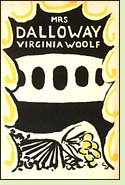Mrs. Dalloway
by Virginia Woolf
Reviewed by Margaret Donsbach

"Mrs. Dalloway said that she would buy the flowers herself." This sentence launches Woolf's classic 1925 novel, an early, brilliant example of the stream-of-consciousness technique in fiction, following its characters' thoughts as they circle and spiral ever deeper into emotionally meaningful themes, despite or because of external distractions. Although Woolf wrote a blazingly contemporary novel, it evokes for today's readers the London of almost a century ago in which dusty social customs had begun slipping away: young women startle the elderly with the narrow, ankle-baring cut of their skirts; Clarissa Dalloway has servants but wants them to like her; men have returned shell-shocked from the war in Europe; the Church is losing its grip on people's beliefs.
And yet the novel is timeless: dense with insight into human nature, filled with breath-catching descriptions of everyday sights and sounds that soar into metaphor. Its point-of-view shifts are themselves metaphorical: people pass each other on the street or are married for decades, and utterly misunderstand each other; all the same, their lives are constantly touching and affecting each other, linked by "that spider's thread of attachment."
On a day in June, Clarissa prepares for the party she will host that evening. The fresh morning air recalls the summer when she was eighteen. She broke off her attachment to Peter Walsh that year and, instead, married Richard Dalloway. Peter "would be back from India one of these days," she thinks. And so it happens: he visits that very morning. Their feelings for each other remain troubling and complex, muted and strong. An awareness of their mortality hangs over them, for no specifically stated reason except that they are, as we all are, mortal. That chance "spider's thread of attachment" links Clarissa, also, to a shell-shocked war veteran haunted by the dead, a tragic figure whom she never meets. His doctor has pompously pronounced that he has "nothing whatever seriously the matter with him," but the man's wife knows better. (1925; 197 pages in the 1981 Harvest edition)
More about Mrs. Dalloway at Powell's Books or Amazon.comOther novels set in England between the wars:
The Hours by Michael Cunningham (1998), a novel about Virginia Woolf in 1923 as she was writing Mrs. Dalloway, a woman reading Woolf's novel in 1949, and a present-day New York woman whose name echoes Mrs. Dalloway's; won the 1999 Pulitzer Prize for Fiction. More info
The Year After by Martin Davies (2011), about a young man who returns from fighting in the trenches and, attending a party at a country house he swore never to return to, begins to question what he understood about events there before the war. More info
The Remains of the Day by Kazuo Ishiguro (1989), about an English butler looking back on his thirty years of service to a lord as he struggles with the social changes of the post-WWI years. More info
Nonfiction about Virginia Woolf and British society between the wars:
The Decline and Fall of the British Aristocracy by David Cannadine (1990), about the social shifts in Britain from the 1880s to the present. More info
Virginia Woolf by Hermione Lee (1997), a biography of Woolf. More info
A Writer's Diary by Virginia Woolf (1953), extracts from Woolf's complete diaries from 1915 to her death in 1941. More info
At the Movies:
Mrs. Dalloway
The Hours
Online:
"A Room of One's Own," the full text (there are a few typos) of Virginia Woolf's speech about women and fiction.
Back to Europe Between the Wars
Back to Directory of Book Reviews